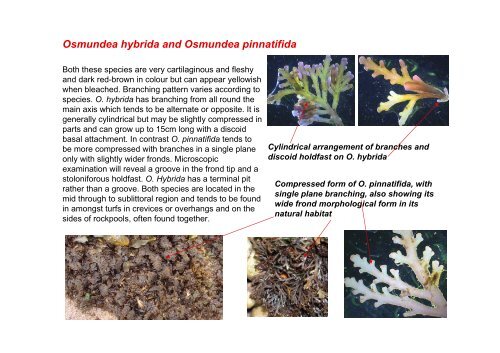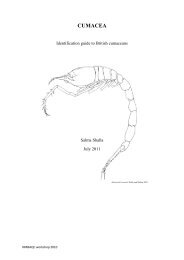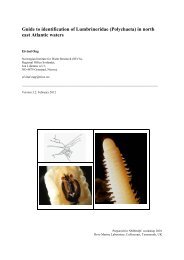s A Field Guide to the British Seaweeds - NMBAQC
s A Field Guide to the British Seaweeds - NMBAQC
s A Field Guide to the British Seaweeds - NMBAQC
Create successful ePaper yourself
Turn your PDF publications into a flip-book with our unique Google optimized e-Paper software.
Osmundea hybrida and Osmundea pinnatifida<br />
Both <strong>the</strong>se species are very cartilaginous and fleshy<br />
and dark red-brown in colour but can appear yellowish<br />
when bleached. Branching pattern varies according <strong>to</strong><br />
species. O. hybrida has branching from all round <strong>the</strong><br />
main axis which tends <strong>to</strong> be alternate or opposite. It is<br />
generally cylindrical but may be slightly compressed in<br />
parts and can grow up <strong>to</strong> 15cm long with a discoid<br />
basal attachment. In contrast O. pinnatifida tends <strong>to</strong><br />
be more compressed with branches in a single plane<br />
only with slightly wider fronds. Microscopic<br />
examination will reveal a groove in <strong>the</strong> frond tip and a<br />
s<strong>to</strong>loniforous holdfast. O. Hybrida has a terminal pit<br />
ra<strong>the</strong>r than a groove. Both species are located in <strong>the</strong><br />
mid through <strong>to</strong> sublit<strong>to</strong>ral region and tends <strong>to</strong> be found<br />
in amongst turfs in crevices or overhangs and on <strong>the</strong><br />
sides of rockpools, often found <strong>to</strong>ge<strong>the</strong>r.<br />
Cylindrical arrangement of branches and<br />
discoid holdfast on O. hybrida<br />
Compressed form of O. pinnatifida, with<br />
single plane branching, also showing its<br />
wide frond morphological form in its<br />
natural habitat




